MEMORY PC4200 DDR2 CHART REVIEW BENCHMARK AND OVERCLOCKING
![]()
|
|
 |
||||||||||||
| Posted:2007-02-27 By memory review Number of View:40100 |
|||||||||||||
By :memory review Posted:2007-02-27
As u know overclocking is obtaining greater performance for small money. As rule, the overclock amateurs choose their video card, processors , operational memory to get the maximum performance. . In the past month we introduced a wide spectrum of memory, produced by OCZ company , between them the inexpensive modules : PC 2-4200 and PC 2-5300. In this review we will check the overclocking capability of low end memory modules : DDR2 PC 2-4200 with volume 1 Gb. In all we succeeded to get in this tests twelve modules or six pairs DDR 2-533 from producers as Patriot, Kingston, Transcend, TwinMOS, Hynix and Samsung: 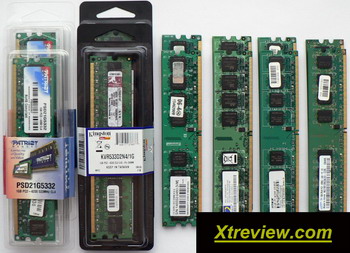 All modules DDR2 SDRAM 240- are without the support of errors correction regime ( regular memory ) , with the double-sided chips arrangement in the packing FBGA. The default voltage of the entire memory composes 1.8 v, effective frequency is equal to 533 MHz with the theoretical capacity of 4.2 Gb/s. Before passing to the testing of memory module, we propose to become acquainted with the test configuration and the testing procedure. 1. Test configuration, instruments and testing procedureMemory was tested in the dual-channel regime on the following configuration :
For cooling the memory modules we installed over them a 80- mm fan from the Austrian company noctua, which rotate at ~1800 RPM. Modules were installed in pairs in the first and third slots . Tests were made in the operating system Windows XP professional edition SP2. For checking the stability of memory with overclock we used the following programs:
First we determine the maximum frequency with the classical for DDR2 SDRAM modules latency 4- 4- 4-12 then 5- 5-5-15 , we also used some advanced values set manually:
The setting static read control present in the BIOS was fixed : disable. After the determination of the maximum frequency at witch work the memory with overclock at default voltage , we increased the latter in the range from 1.8 to 2.1v, frequency, as it result, can be increased increase, and then we repeated the tests cycle again . The decrease of parameter DRAM RAS # active to precharge, as showed test in all budget modules easily transfer up to the value 4. But in this case the optimum for performance range of this parameter are 8-12 (the difference in the tests is visible in WinRAR and the latency test from Everest). 2. Testing memory module with volume 2 X 1 Gb
The North American company patriot is already well familiar to our permanent visitors. We repeatedly tested both expensive dual-channel complete sets, produced under this trade mark, and also budget modules.  The memory patriot PSD21G5332 by volume 1 Gb relates to the standard PC 2-4200, it functions at the default frequency 533 MHz with voltage 1.8 v with CAS latency 4. In spite of their budget price, modules are supplied in the transparent plastic boxes: 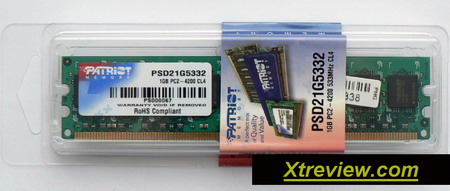 The presence of this box and reduces to the minimum the possibility of random damage to this product. Modules have the green color PCB: 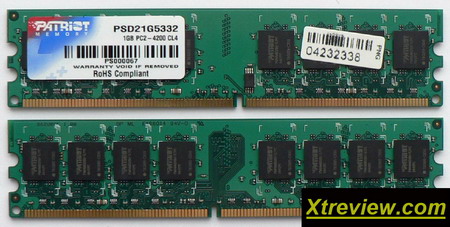 There are no radiators on memory chips. on USA the memory patriot has life time guarantee. On the sticker it is possible to reveal the following information: The patriot company in the production of memory uses microcircuits of its own production: 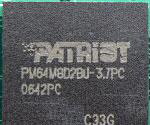 Their marking is : PM64M8D2BU-3.7PC . On the official site are present the minimally informative specifications of this memory (PDF, 332 KB). The microcircuit modules by SPD have the following information configuration : 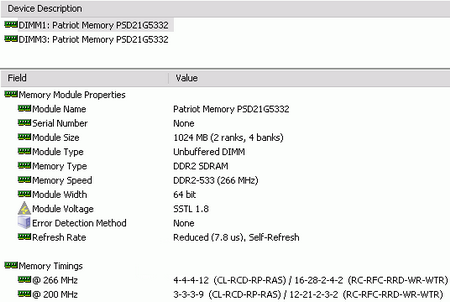 The Latency for default frequency 533 MHz compose 4- 4- 4-12. In addition to this software communicates that this memory is capable of working with latency 3- 3- 3-9, but only at 400 MHz. frequency . Overclocking the potential of memory module PC 2-4200 Patriot proved to be easy. First on the default voltage with 1.8 v and latency 4- 4- 4-12 memory frequencies was possible to increase only by 129 MHz with total 662 MHz. But when we increase the voltage to 2.1 v is capable , This was sufficient to reveal the full module potential with frequency 786 MHz or + 47.5% over the default rating. But if the high frequency is necessary , then we have to increase the latency to 5-5-5-15 and we obtain in this case stable 880 MHz with 2.1 v. The most rapid regime on the memory speed operation after our tests became the 786 MHz with latency 4- 4- 4-12. In addition we was able to reduce other latencies value to the following :
The benchmark of memory from Everest presents the following results with overclocked patriot memory in the dual-channel regime: 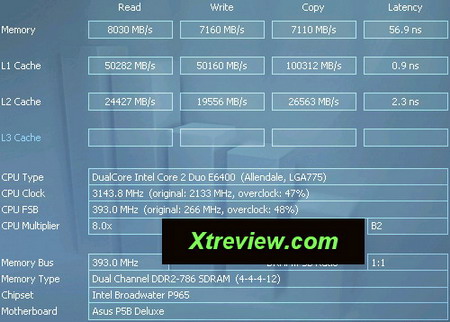 I will add that the cost of one module patriot PSD21G5332 with the volume 1 Gb is 66 $ .
The production of company kingston is popular on the worldwide market. We will test the budget modules kingston PC 2-4200 KVR533D2N4/1G witch are also supplied in the plastic boxes: 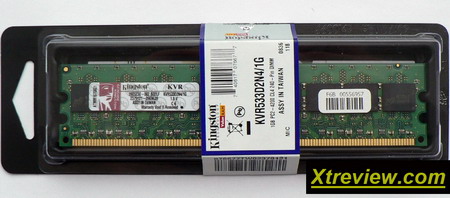 On the plastic box, which serve as packing, is represented complete information about the module and its characteristics. Inside the packing besides memory is located the brief user management : 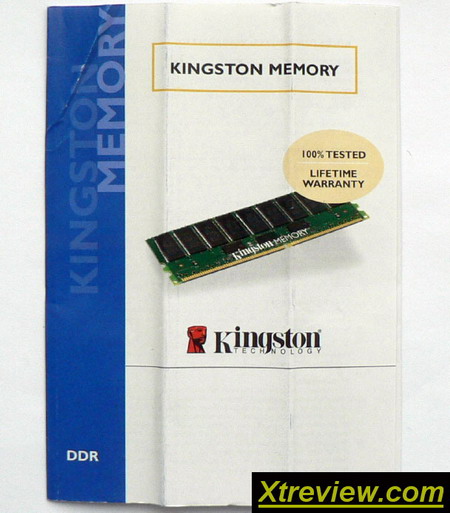 The same as in Patriot, green printed-circuit board is used : 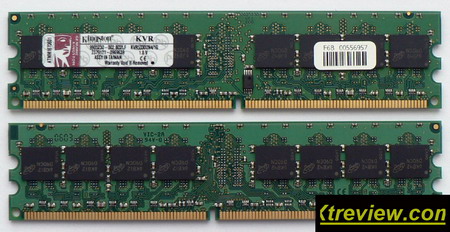 On the other sides of memory we have the information about module Besides different code designations : we can see here information about the country where the memory was produced (Taiwan), default voltage 1.8 v, and also the marking of modules : KVR533D2N4/1G. With respect to marking I will add that on the official site of kingston company there is a convenient schematic interpretation of this line for DDR and DDR2 memory: 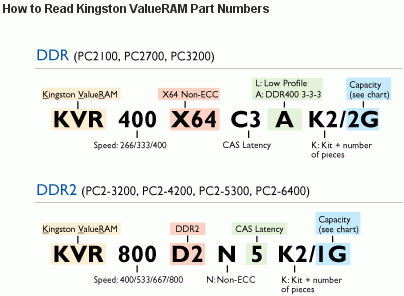 Thus, on the KVR533D2N4/1G it is possible to draw the conclusion that before us budget (ValueRAM) operational memory DDR2 with frequency 533 MHz, without support to errors correction , with CAS latency 4, volume 1 Gb. The memory chips producer is Micron: 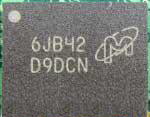 Marking : 6JB42 D9DCN. are most popular among overclocker . SPD of memory module kingston appears as follows:  As we see, the default frequency is 533 MHz there are two latency versions : for the frequency 400 MHz. Furthermore, in SPD it is possible to reveal the module series number and also the production date . Unfortunately, in overclock the budget modules from kingston proved to be a little bit worse than Patriot, but in this case I cannot say that their overclocking potential proved to be low. Without increase in voltage with latency 4- 4- 4-12 memories was even better than Patriot, after driving reaching the frequency 667 MHz. A step-by-step increase in the voltage to 2.1 v without change in latency allowed this memory to stably operate at 774 MHz (+ 42.5%). Using the latency 5-5-5-15 the memory worked at 754 MHz and 820 MHz with voltage 1.8 and 2.1 volts, respectively. As a result the most rapid mode proved to be the regime 774 MHz with latency 4- 4- 4-12. In this case also we set the latency value to the indicated-below values:
The results of benchmark in Everest with the minimum latencies and frequency reached are presented on the screen shot: 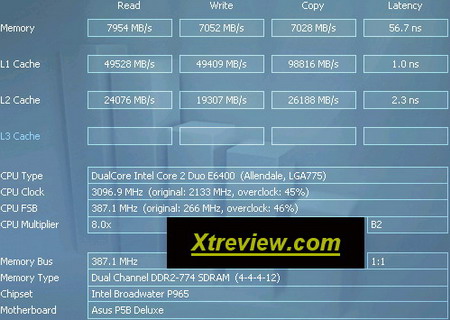 The cost of one memory module kingston PC 2-4200 KVR533D2N4/1G is 73 $. The specifications of this memory can be downloaded from the official site (PDF, 110 KB).
Now we pass to the memory from company transcend. The first impression with this modules is ambiguous. : 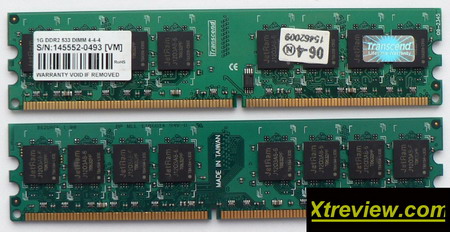 On usual sticker besides the bar code and the number series we find information about the memory volume , the default frequency and the basic latencies
We also found information about the life time guarantee . 16 chips are JetRam J12Q3AB- 6 T0632PF: 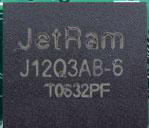 You can find all the specification of this memory in the official site with the appropriate document (PDF, 369 KB), we then checked the SPD values : 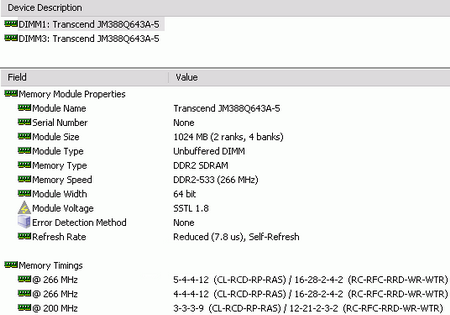 With exception of module producer , series number and release date, before us information, practically identical to the mentioned in the recently examined memory kingston. But here in overclock , transcend jetRam PC 2-4200 JM388Q643A- 5 demonstrated different results from Kingston. Thus, with latency 4- 4- 4-12 and at the default voltage the memory stably functioned at the frequency of 724 MHz, which almost 60 MHz higher than two previous results under the same conditions. Further, increase in voltage on the memory module to 2.1 v allow to raise its frequency to 880 MHz, i.e., + 65.1% from the default frequency. amazing result! With latency 5-5-5-15 the overclocking result proved to be better: 790 MHz with 1.8 v and 938 MHz with 2.1 v (+ 76% over the default frequency). Last result, as you understand, proved to be in the best in plan of performance. After the determination of maximum frequency of the memory work , transcend was with the basic latencies 5-5-15 and here we lowered and the following additional values:
The results of memory benchmark with Everest are presented below: 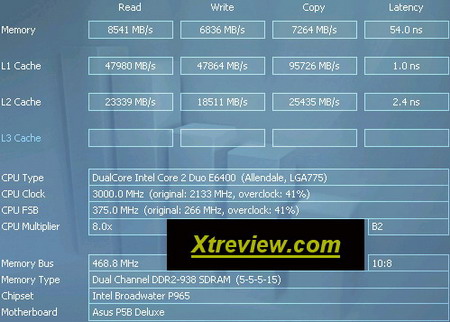 Due to the state 15.02.2007 , one memory module transcend jetRam PC 2-4200 JM388Q643A- 5 with the volume 1 Gb costs 88 $ (most expensive memory between those tested today ).
We have here another memory producer : twinMOS company .  The pair of modules is supplied without any packing. They have the Pale-green PCB with 16 memory chips DDR2:  Microcircuits are not closed with radiators Series number, correspond to the standard PC 2-4200 and the memory volume is also present TwinMOS PC 2-4200 8D22KB-MK is based on chips m.tec: 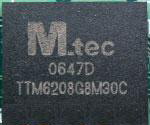 Marking chips : TTM6208G8M30C. The memory specifications are absent on the official site :-(. Here is the SPD information: 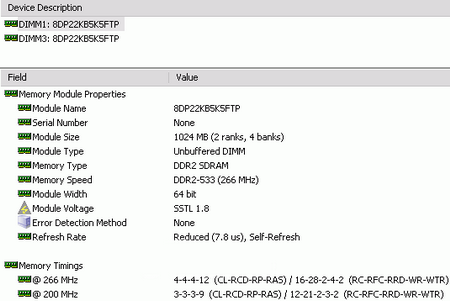 Latency for the default frequency 533 MHz compose 4- 4- 4-12, and from here we start to study their overclocking potential. Thus, at the default voltage 1.8 v twinMOS succeeded to work at 744 MHz. Further increase in the voltage allow to increase the memory frequency by 100 MHz with total 842 MHz : the best result from the already examined modules. With increase in the latency to 5-5-5-15 at the default frequencies and voltage the memory work at 805 MHz, while with 2.1v This memory overclock to 950 MHz (+ 78.2% over the rating). Splendid result for budget memory! Specifically, this regime became the performance regime used . As always we can tweak more the memory latency with those values :
After overclock and reduction in latency , in Everest benchmark we obtained the following results: 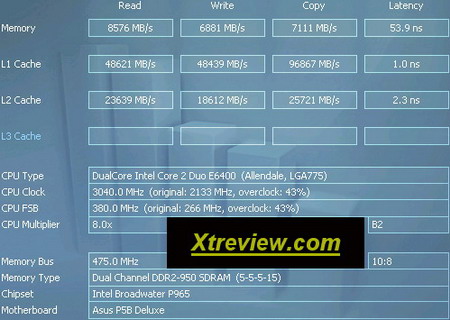 The cost of one giga-byte module twinMOS PC 2-4200 8D22KB-MK is 68$ .
Because of its low cost as rule and high overclocking potential, the memory from company hynix has for long time gained the confidence of overclocker. We repeatedly tested the memory of this producer and most frequently we get good result .  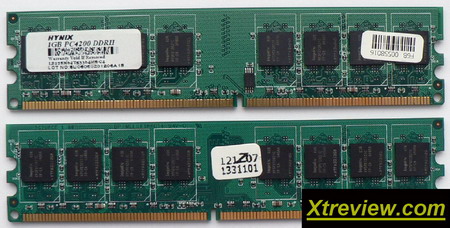 Everything is normal: the memory come with marking Hynix- a. On the original modules hynix sticks narrow and long sticks has orange color and a noticeably larger quantity of useful information, than on the photo given . It is possible to only assume that this memory is produced by some hynix partners and here we hope that its overclocking potential will not be worse than in the original modules from this producer. Marking memory microcircuits is HY5PS12821C FP-C4: 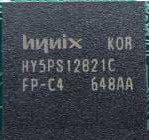 The specifications of chips can be downloaded from the official site (PDF, 4.1 mb.). There it is possible to find the diagram to interpret the marking of DDR2 hynix memory : 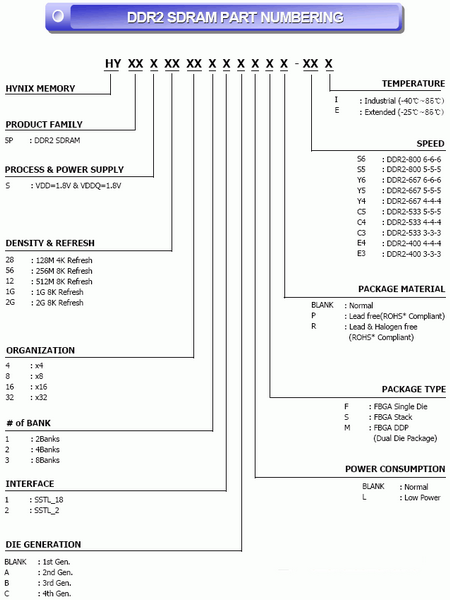 Contents of the SPD microcircuit hynix modules confirmed our guesses before us an hybrid version : 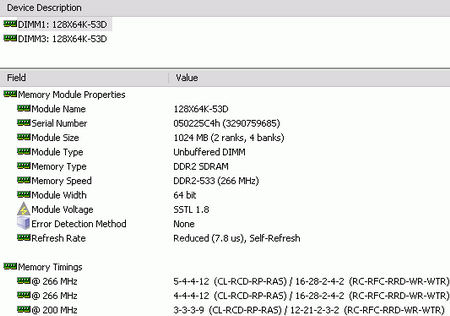 The mysterious name of module 128X64K-53D, which resembles the memory organization diagram , do not refers to Hynix. with latency 4- 4- 4-12 and default voltage the memory succeeded to overclock only to 706 MHz. A change in the voltage on modules in the range from 1.8 to 2.1v allow to raise their frequency by 44 MHz with total 750 MHz (at 2.1 volts). With latency 5-5-5-15 we has rather better result, since at the frequency 855 MHz it was not necessary to raise the voltage . 2.1 v minimally influenced the overclocking potential of hynix memory : increase was only 18 MHz with final 873 MHz (+ 63.8% over the rating). The hynix chips examined minimally depend on the supplied voltage. We as always tweaked the memory latencies in frequency 873 MHz and we reached the following values:
Moreover, the parameter DRAM CAS # latency without the loss of stability was also lowered from 5 to 4 . As result we got a completely decent results in Everest benchmark : 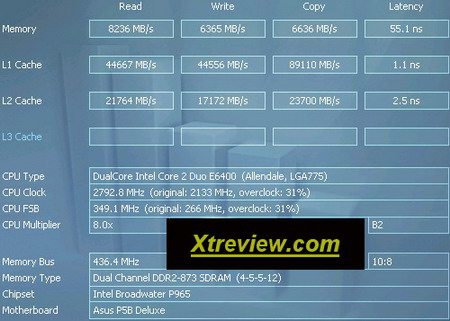 The cost of one module hynix PC 2-4200 HY5PS12821C with volume 1 Gb is 72$ .
The company samsung is the quite important memory producer . .  Two modules with the green color PCB : 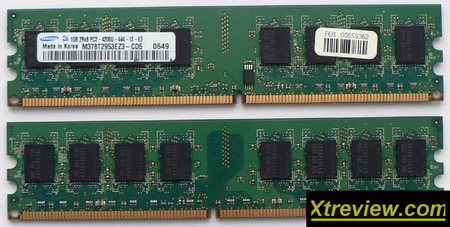 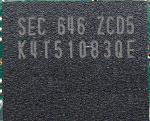 Memory capacity, standard, basic latencies, the production country and marking modules, and also the release date (49 week 2006) this information can be learned on the contents of sticker. The microcircuits Marking is K4T51043QE-ZCD5 On the official site of company samsung it is possible to find detailed technical information from the given microcircuits and also to download their specification (PDF, 583 KB). Let us look to the SPD values: 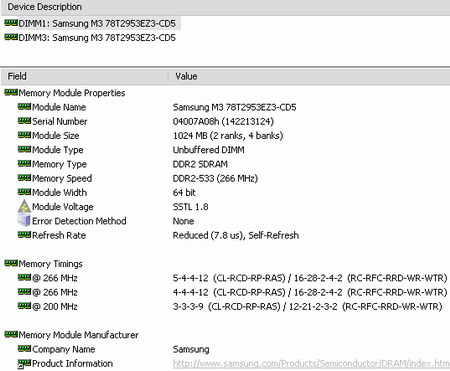 The combinations of latency and frequencies do not differ from the majority of examined today modules . Without increase in the voltage with latency 4- 4- 4-12 memories stably functioned at the frequency of only 674 MHz, and with increase in the voltage to 2.1 v we got only 690 MHz. Very and very weak result. with 5-5-5-15 Samsung PC 2-4200 M378T2953EZ 3- CD5 appears better, but it not demonstrate anythings special. With the default voltage 1.8 v we got 824 MHz and practically the same overclock value with 2.1 v : 833 MHz (+ 56.3% over the rating). It present minimum dependence on the supplied chips voltage . The smallest possible latency with overclock reached proved to be the following:
As consequence, the memory benchmark results from Everest are sufficiently modest: 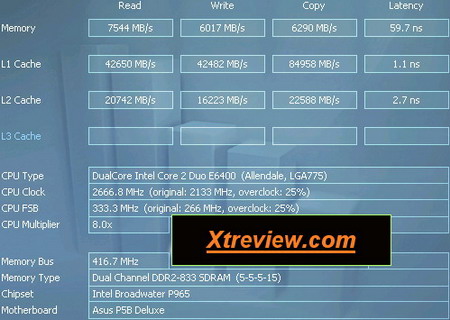 From 15.02.2007 one module samsung PC 2-4200 M378T2953EZ 3- CD5 with volume 1 Gb costs 84$ . 3. Total testing resultsConclusionThe first conclusion, which would be desirable to make from today\'s review that overclockers has a completely interesting selection from budget DDR2 memory PC 2-4200. If u look for memory with standard PC 2-6400 frequency 800 MHz, then u can get budget memory ( no need to overpay for such modules ). . As it is evident from this review , most memory without exception can work at frequency 800 MHz. At the same time the difference between budget 1 Gb by modules with default frequency 533 MHz and 800 MHz today comprises not less than 20-25 US dollars, which during the acquisition of two modules PC 2-4200 will lead to savings in 40-50 US dollars. If we approach the estimation of overclocking possibilities for the tested today , then we have out of competition twinMOS PC 2-4200 8D22KB-MK, which work at frequency 950 MHz with voltage 2.1 v. we should also note the high capability of memoru from transcend production ; however, the cost of (two modules) is exactly higher by 50 dollars , which is critical for this price segment.
we would be happy to answer for your question . if you have suggestion or comment
regarding this review our support would be glad to help just join our forum and ask u will get the best answer
to discuss check our forum section :-) RATE THIS REVIEW | |||||||||||||
![]()

Memory pc4200 ddr2 chart review benchmark and overclocking
Memory pc4200 ddr2 chart review benchmark and overclocking


7600gt review
7600gt is the middle card range.
We already benchmarked this video card and found that ...

 geforce 8800gtx and 8800gts
geforce 8800gtx and 8800gts  Xtreview software download Section
Xtreview software download Section  AMD TURION 64 X2 REVIEW
AMD TURION 64 X2 REVIEW  INTEL PENTIUM D 920 , INTEL PENTIUM D 930
INTEL PENTIUM D 920 , INTEL PENTIUM D 930  6800XT REVIEW
6800XT REVIEW  computer hardware REVIEW
computer hardware REVIEW  INTEL CONROE CORE DUO 2 REVIEW VS AMD AM2
INTEL CONROE CORE DUO 2 REVIEW VS AMD AM2  INTEL PENTIUM D 805 INTEL D805
INTEL PENTIUM D 805 INTEL D805  Free desktop wallpaper
Free desktop wallpaper  online fighting game
online fighting game  Xtreview price comparison center
Xtreview price comparison center 

- The new version of GPU-Z finally kills the belief in the miracle of Vega transformation
- The motherboard manufacturer confirms the characteristics of the processors Coffee Lake
- We are looking for copper coolers on NVIDIA Volta computing accelerators
- Unofficially about Intels plans to release 300-series chipset
- The Japanese representation of AMD offered monetary compensation to the first buyers of Ryzen Threadripper
- This year will not be released more than 45 million motherboards
- TSMC denies the presentation of charges from the antimonopoly authorities
- Radeon RX Vega 64 at frequencies 1802-1000 MHz updated the record GPUPI 1B
- AMD itself would like to believe that mobile processors Ryzen have already been released
- AMD Vega 20 will find application in accelerating computations
- Pre-orders for new iPhone start next week
- Radeon RX Vega 57, 58 and 59: the wonders of transformation
- ASML starts commercial delivery of EUV-scanners
- The older Skylake processors with a free multiplier are removed from production
- Meizu will release Android-smartphone based on Helio P40
- AMD Bristol Ridge processors are also available in American retail
- The fate of Toshiba Memory can be solved to the next environment
- duo GeForce GTX 1080 Ti in GPUPI 1B at frequencies of 2480-10320 MHz
- New Kentsfield overclocking record up to 5204 MHz
- Lenovo released Android-smartphone K8



computer news computer parts review Old Forum Downloads New Forum Login Join Articles terms Hardware blog Sitemap Get Freebies

